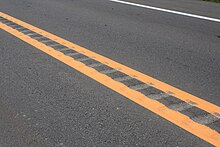Rumble strips
Rumble strips (Engl. Rumble strips) are part of the street furniture and serve to make the driver to certain dangers. The mode of action of the vibrating strips is based on the fact that vibrations and noises are conveyed to the vehicle driver when the vehicle tire is driven over it. Vibrating strips are used to delimit traffic lanes and lanes and are intended to prevent vehicle drivers from not noticing that the lane is being driven over (e.g. due to fatigue). They also serve as a speed reduction measure in front of obstacles on the route, such as junctions or tight curve radii.
Basically there are two ways to apply vibrating strips to the roadway. The first possibility is to apply a road marking that has a corresponding layer thickness and / or surface structure. The second option is to mill recesses in the road surface.
application

Vibrating strips are used in many countries. For example, these can be found in the United States , Mexico , Denmark , Austria , Italy or France .
Netherlands
Rumble strips have been used in the Netherlands since the early 1990s, which reduced the number of road deaths there by around a third by 2007.
Germany
In Germany , rumble strips are currently only being used on a trial basis or very rarely. The most famous rumble strips are milled into the surface in Brandenburg on the A24 near Fehrbellin and Herzsprung . According to studies by the Federal Highway Research Institute, dangling accidents there fell by 43 percent in the test period, and the number of seriously injured or killed car occupants fell by 15 percent.
Web links
- Article about the rumble strips at focus.de
- Article about the rumble strips at SPIEGEL ONLINE
Individual evidence
- ↑ a b Article on the rumble strips at SPIEGEL ONLINE, accessed on November 1, 2010
- ↑ BASt press release of January 19, 2009 with information on creating a rumble strip and experiences from the test area on the A24 , PDF (653 kB), accessed on June 6, 2012
